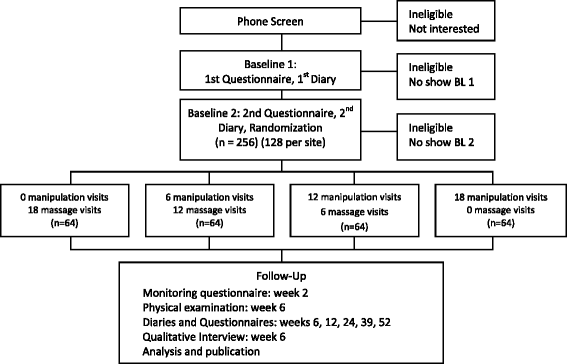Dose-response of spinal manipulation for cervicogenic headache: study protocol for a randomized controlled trial
- PMID: 27280016
- PMCID: PMC4898300
- DOI: 10.1186/s12998-016-0105-z
Dose-response of spinal manipulation for cervicogenic headache: study protocol for a randomized controlled trial
Abstract
Background: Cervicogenic headache is a prevalent and costly pain condition commonly treated by chiropractors. There is evidence to support the effectiveness for spinal manipulation, but the dose of treatment required to achieve maximal relief remains unknown. The purpose of this paper is to describe the methodology for a randomized controlled trial evaluating the dose-response of spinal manipulation for chronic cervicogenic headache in an adult population.
Methods/design: This is a mixed-methods, two-site, prospective, parallel groups, observer-blind, randomized controlled trial conducted at university-affiliated research clinics in the Portland, OR and Minneapolis, MN areas. The primary outcome is patient reported headache frequency. Other outcomes include self-reported headache intensity, disability, quality of life, improvement, neck pain intensity and frequency, satisfaction, medication use, outside care, cervical motion, pain pressure thresholds, health care utilization, health care costs, and lost productivity. Qualitative interviews are also conducted to evaluate patients' expectations of treatment.
Discussion: With growing concerns regarding the costs and side effects of commonly used conventional treatments, greater numbers of headache sufferers are seeking other approaches to care. This is the first full-scale randomized controlled trial assessing the dose-response of spinal manipulation therapy on outcomes for cervicogenic headache. The results of this study will provide important evidence for the management of cervicogenic headache in adults.
Trial registration: ClinicalTrials.gov (Identifier: NCT01530321).
Keywords: Cervicogenic headache; Chiropractic; Mixed methods; Randomized controlled trial; Spinal manipulation.
Similar articles
-
Dose-response and efficacy of spinal manipulation for care of cervicogenic headache: a dual-center randomized controlled trial.Spine J. 2018 Oct;18(10):1741-1754. doi: 10.1016/j.spinee.2018.02.019. Epub 2018 Feb 23. Spine J. 2018. PMID: 29481979 Free PMC article. Clinical Trial.
-
An Additive Effect of Instrument-Assisted Soft Tissue Mobilization with Spinal Manipulation in Cervicogenic Headache: a Randomized Controlled Trial.Pain Ther. 2024 Dec;13(6):1679-1693. doi: 10.1007/s40122-024-00671-w. Epub 2024 Oct 28. Pain Ther. 2024. PMID: 39467979 Free PMC article.
-
Spinal manipulation and perineural electrical dry needling in patients with cervicogenic headache: a multicenter randomized clinical trial.Spine J. 2021 Feb;21(2):284-295. doi: 10.1016/j.spinee.2020.10.008. Epub 2020 Oct 13. Spine J. 2021. PMID: 33065273 Clinical Trial.
-
Methodological quality of randomized controlled trials of spinal manipulation and mobilization in tension-type headache, migraine, and cervicogenic headache.J Orthop Sports Phys Ther. 2006 Mar;36(3):160-9. doi: 10.2519/jospt.2006.36.3.160. J Orthop Sports Phys Ther. 2006. PMID: 16596892 Review.
-
Efficacy of spinal manipulation for chronic headache: a systematic review.J Manipulative Physiol Ther. 2001 Sep;24(7):457-66. J Manipulative Physiol Ther. 2001. PMID: 11562654
Cited by
-
Bibliometric Analysis of Research Trends on Tuina Manipulation for Neck Pain Treatment Over the Past 10 Years.J Pain Res. 2023 Jun 15;16:2063-2077. doi: 10.2147/JPR.S410603. eCollection 2023. J Pain Res. 2023. PMID: 37342612 Free PMC article. Review.
-
On-Site Chiropractic Care as an Employee Benefit: A Single-Location Case Study.J Chiropr Med. 2017 Sep;16(3):183-188. doi: 10.1016/j.jcm.2017.03.001. Epub 2017 Sep 22. J Chiropr Med. 2017. PMID: 29097946 Free PMC article.
-
Dose-response and efficacy of spinal manipulation for care of cervicogenic headache: a dual-center randomized controlled trial.Spine J. 2018 Oct;18(10):1741-1754. doi: 10.1016/j.spinee.2018.02.019. Epub 2018 Feb 23. Spine J. 2018. PMID: 29481979 Free PMC article. Clinical Trial.
References
-
- Atlas of headache disorders and resources in the world 2011. A collaborative project of World Health Organization and Lifting The Burden. Geneva: WHO; 2011.
-
- Bronfort G, Nilsson N, Haas M, Evans R, Goldsmith CH, Assendelft WJ, Bouter LM. Non-invasive physical treatments for chronic/recurrent headache. Cochrane Database Syst Rev. 2004(3):Cd001878 - PubMed
-
- The International Classification of Headache Disorders, 3rd edition (beta version). Cephalalgia. 2013, 33(9):629–808 - PubMed
Associated data
Grants and funding
LinkOut - more resources
Full Text Sources
Other Literature Sources
Medical


